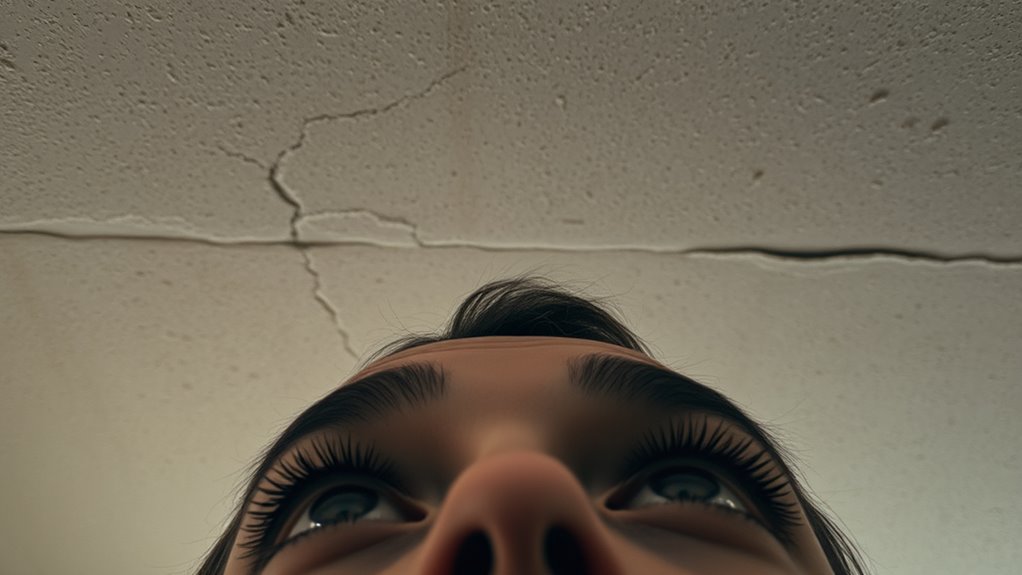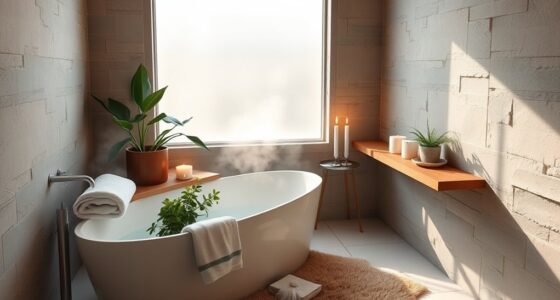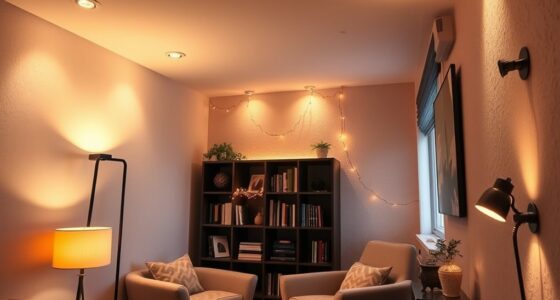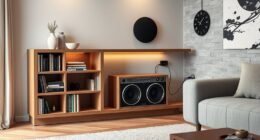To make low ceilings feel taller, draw your eyes upward with strategic design choices. Use light, neutral colors on ceilings and upper walls to reflect more light and create an airy feel. Add vertical stripes or patterns on walls, and incorporate tall, narrow furniture or accessories that guide your gaze upward. Hang curtains high above windows and install crown molding to emphasize the boundary above. These simple tips help create the illusion of extra height—keep exploring to learn more ways to elevate your space.
Key Takeaways
- Use light, neutral colors on ceilings and upper walls to reflect light and create a sense of height.
- Incorporate vertical stripes or patterns on walls to guide the eye upward visually.
- Install crown molding or decorative trim near the ceiling to emphasize the boundary and draw attention upward.
- Position tall, narrow furniture and vertical accessories like lamps to direct focus vertically.
- Use upward-facing lighting or wall-mounted sconces to cast light toward the ceiling, enhancing the perception of height.
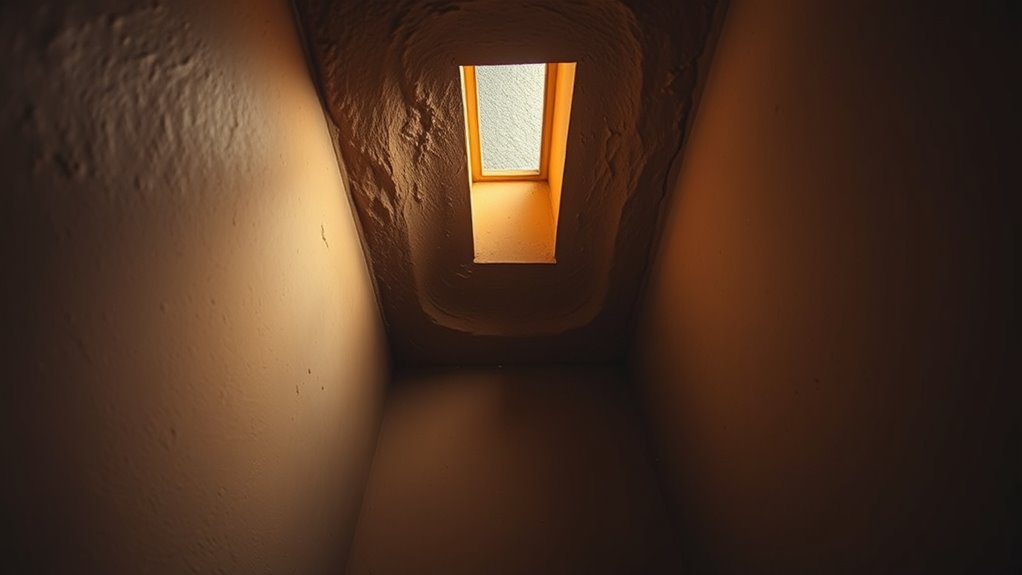
Ever wonder how to make a room with low ceilings feel taller and more spacious? The trick lies in understanding how ceiling height influences spatial perception. When ceilings are low, your brain tends to interpret the space as cramped or confined, but you can counteract this effect by drawing the eye upward. By focusing on vertical design elements, you activate the perception of height, making the room seem more open and airy. The key is to manipulate visual cues that emphasize upward movement, helping you create an illusion of greater ceiling height.
Start by choosing colors strategically. Light, neutral shades on the ceiling and upper walls reflect more light and give the impression of greater height. Dark colors tend to close in space, so avoid painting the ceiling a darker hue than the walls. Instead, keep it a few shades lighter or in a similar tone to maintain a seamless flow that directs your gaze upward naturally. Additionally, vertical stripes or patterns on walls can elongate the perceived height of the room. These patterns create a visual cue that guides your eyes vertically, enhancing the sense of spaciousness.
Use light, neutral colors and vertical patterns to visually extend ceiling height and create a more spacious feel.
Incorporate tall, narrow furniture pieces and vertical accessories like tall lamps, narrow shelving units, or vertical artwork. These elements break the horizontal plane, encouraging your eyes to follow their lines upward. Hang curtains high above the window frame, close to the ceiling, rather than directly at the window sill. This small adjustment extends the visual height of the window, drawing attention upward and making the ceiling appear higher. Also, consider installing crown molding or decorative trim near the ceiling. When painted in a contrasting color or left white, these details emphasize the boundary between wall and ceiling, subtly elevating the spatial perception.
Lighting plays a pivotal role as well. Use wall-mounted sconces or upward-facing lights to cast light toward the ceiling rather than down into the room. This technique creates an upward glow that lifts the space visually. Skylights or large windows, if feasible, also help flood the room with natural light, further expanding the sense of height. In the end, keep clutter minimal and opt for simple, streamlined decor. Overly busy or bulky furnishings can make a room feel more cramped, so maintaining a clean, airy aesthetic allows your visual focus to stay directed upward.
Frequently Asked Questions
Can Specific Color Schemes Make Ceilings Appear Taller?
You wonder if color schemes can make ceilings seem taller. Yes, they can! Using high contrast between ceiling and wall colors draws attention upward, creating the illusion of height. Light, monochromatic shades make ceilings appear higher, while bold ceiling patterns or darker shades can shorten the space. Strategic color contrast and ceiling patterns are effective tricks to visually lift a room with low ceilings, making it feel more spacious.
Are There Particular Furniture Styles That Enhance Ceiling Height?
Sometimes, subtle choices can create a ceiling illusion that elevates your space. You’ll want to focus on furniture style that emphasizes vertical lines, like tall shelving or slender pieces, which draw the eye upward. Avoid bulky or overly horizontal designs that flatten the room’s height. By selecting furniture that directs attention upward, you enhance the sense of height, making your low ceilings feel more expansive and open.
How Do Lighting Choices Influence the Perception of Ceiling Height?
Lighting choices markedly influence how you perceive ceiling height. Bright, layered lighting draws the eye upward, making ceilings seem taller. You can also enhance this effect with wall textures that reflect light, creating depth. Incorporating ceiling beams can add visual interest and emphasize height, especially when lit properly. Combining thoughtful lighting with textured walls and ceiling beams helps your space feel more open and airy, even in low-ceiling rooms.
Does the Room’s Shape Affect the Effectiveness of Visual Tricks?
Did you know that over 60% of people feel more comfortable in rooms with well-designed optical illusions? The shape of a room is vital in the effectiveness of these visual tricks, influencing your visual perception. A rectangular room might enhance the illusion of height, while irregular shapes can distract and diminish this effect. So, your room’s shape plays an essential role in how well optical illusions work to create the perception of higher ceilings.
Can Artwork Placement Impact the Feeling of Ceiling Height?
You can influence how tall a ceiling feels by carefully placing artwork. Positioning pieces higher encourages visual balance and draws attention upward, enhancing the sense of height. Using architectural symmetry in your decor also helps create a cohesive look that tricks the eye into perceiving more space. By focusing on these details, you make the room feel more open and airy, even with low ceilings.
Conclusion
By drawing the eye upward, you can make low ceilings feel more spacious and inviting. Studies show that visual tricks like this can increase perceived room height by up to 20%. So, next time you’re decorating, remember to use vertical lines, tall artwork, or light colors to guide the eye upward. It’s a simple trick that can dramatically change your space, making it feel brighter, larger, and more open—without knocking down a single wall.
